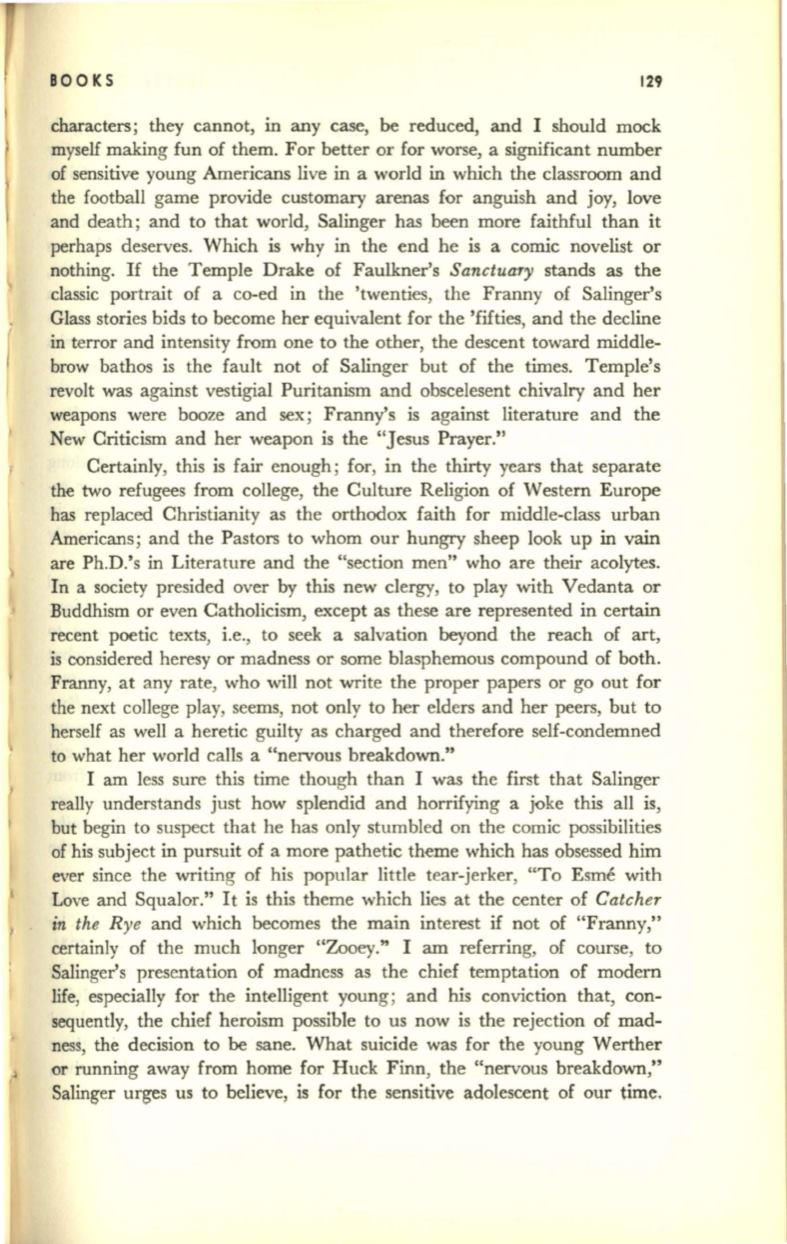
BOOKS
129
characters; they cannot, in any case, be reduced, and I should mock
myself making fun of them. For better or for worse, a significant number
of sensitive young Americans live in a world in which the classroom and
the football game provide customary arenas for anguish and joy, love
and death; and to that world, Salinger has been more faithful than it
perhaps deserves. Which is why in the end he is a comic novelist or
nothing.
If
the Temple Drake of Faulkner's
Sanctuary
stands as the
classic portrait of a co-ed in the 'twenties, the Franny of Salinger's
Glass stories bids to become her equivalent for the 'fifties, and the decline
in terror and intensity from one to the other, the descent toward middle–
brow bathos is the fault not of Salinger but of the times. Temple's
revolt was against vestigial Puritanism and obscelesent chivalry and her
weapons were booze and sex; Franny's is against literature and the
New Criticism and her weapon is the "Jesus Prayer."
Certainly, this is fair enough; for, in the thirty years that separate
the two refugees from college, the Culture Religion of Western Europe
has replaced Christianity as the orthodox faith for middle-class urban
Americans; and the Pastors to whom our hungry sheep look up in vain
are Ph.D.'s in Literature and the "section men" who are their acolytes.
In a society presided over by this new clergy, to play with Vedanta or
Buddhism or even Catholicism, except as these are represented in certain
recent poetic texts, i.e., to seek a salvation beyond the reach of art,
is considered heresy or madness or some blasphemous compound of both.
Franny, at any rate, who will not write the proper papers or go out for
the next college play, seems, not only to her elders and her peers, but to
herself as well a heretic guilty as charged and therefore self-condemned
to what her world calls a "nervous breakdown."
I am less sure this time though than I was the first that Salinger
really understands just how splendid and horrifying a joke this all is,
but begin to suspect that he has only stumbled on the comic possibilities
of his subject in pursuit of a more pathetic theme which has obsessed him
ever since the writing of his popular little tear-jerker, "To Esme with
Love and Squalor." It is this theme which lies at the center of
Catcher
in the Rye
and which becomes the main interest if not of "Franny,"
certainly of the much longer "Zooey." I am referring, of course, to
Salinger's presentation of madness as the chief temptation of modern
life, especially for the intelligent young; and his conviction that, con–
sequently, the chief heroism possible to us now is the rejection of mad–
ness, the decision to
be
sane. What suicide was for the young Werther
or running away from home for Huck Finn, the "nervous breakdown,"
Salinger urges us to believe, is for the sensitive adolescent of our time.


